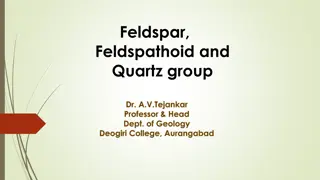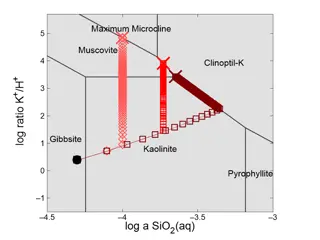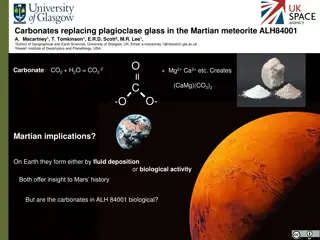Overview of Feldspar Group in Geology: Types, Composition, and Properties
The Feldspar Group is a vital component of rock-forming silicates found in various types of rocks. Comprising two main types - Alkali Feldspar and Plagioclase Feldspar, they exhibit distinct chemical compositions and physical properties. These alumino-silicates are characterized by their atomic stru
2 views • 10 slides
Understanding Reaction Path Traces in GWB12
Visualizing reaction path traces in GWB12 using Act2 or Tact diagrams helps in analyzing how mineral stability and fluid chemistry evolve during reactions like K-feldspar titration. By overlaying multiple traces, customizing markers and lines, users can explore the impact of different silica polymor
0 views • 6 slides
Understanding Raw Materials in Ceramic Production
Raw materials play a crucial role in ceramic production, with three main groups identified - plastic materials like clay, non-plastic or leading mixtures such as silica, and fluxes/mineralizers like feldspar. These materials undergo various transformations during the manufacturing process, contribut
0 views • 29 slides
Understanding Porcelain and Feldspar in Ceramics
Brick clays high in alkalis and iron but low in alumina facilitate forming processes. Porcelain, made from Kaolin, quartz, and feldspar, is a vitreous ceramic fired at high temperatures. Different types of porcelain, including soft-paste and hard-paste, vary in clay and alumina content affecting fir
0 views • 4 slides
Understanding Common Rock-Forming Minerals with K. Guru Brahmam
Explore the six common rock-forming minerals including quartz, feldspar, mica, olivine, pyroxene, and amphibole with insights from K. Guru Brahmam, a lecturer in the Department of Geology. Learn how these minerals are essential tools in classifying rocks and determining their color and composition.
0 views • 13 slides
Carbonates Replacing Plagioclase Glass in Martian Meteorite ALH84001
The carbonates replacing plagioclase glass in the Martian meteorite ALH84001 have raised questions about their origin - whether they are biologically formed or through other geological processes. Discovered in Antarctica in 1984, this meteorite has been dated to over 4 billion years and initially mi
0 views • 14 slides





